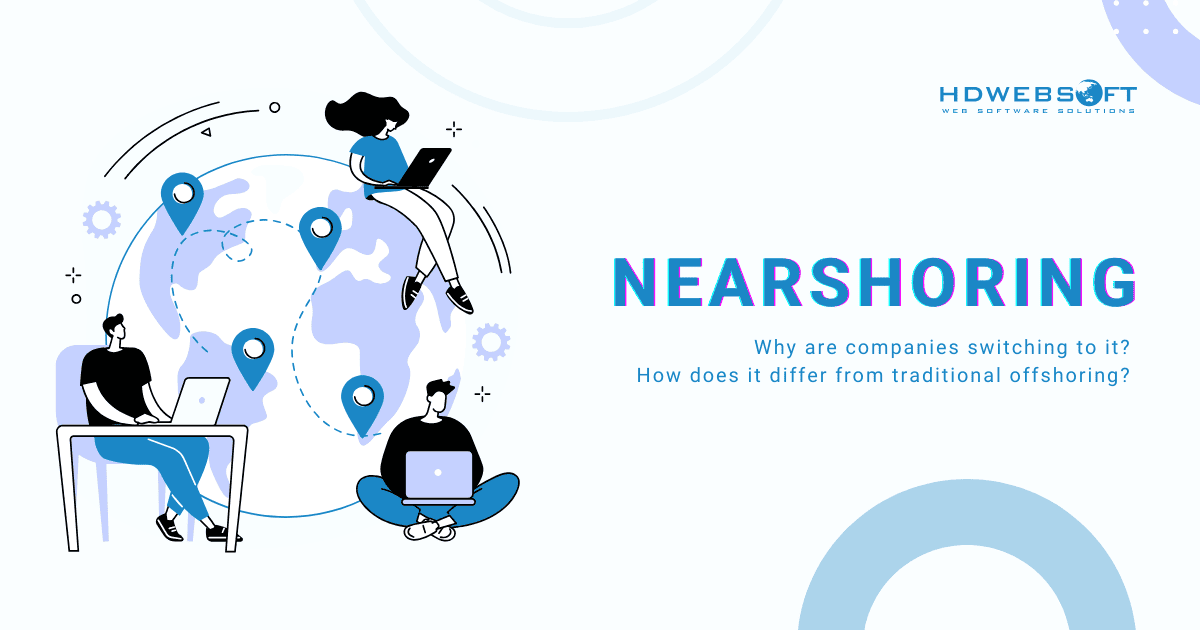
Why Are Companies Switching to Nearshoring?
Nearshoring is driving a profound transformation in the global outsourcing landscape. While traditional offshoring to distant countries once dominated the market, 2025 has witnessed an unprecedented migration toward regional outsourcing strategies. It’s a shift that’s fundamentally reshaping how businesses approach international partnerships.
Companies are discovering that geographical proximity doesn’t merely offer convenience. Rather, it provides tangible competitive advantages that directly impact their bottom line and operational efficiency.
As organizations evaluate their software outsourcing service options, the distinction becomes increasingly significant for strategic decision-making.
- 1) Understanding the Nearshoring Revolution
- 2) Deconstructing Total Cost of Ownership When Outsourcing to Neighboring Countries
- 3) HDWEBSOFT’s Nearshoring Excellence
- 4) Statistical Evidence Supporting the Nearshoring Trend
- 5) Strategic Advantages That Extend Beyond Economics
- 6) Transitioning to Regional Outsourcing Successfully
- 7) Embracing Nearshoring for Competitive Advantage
Understanding the Nearshoring Revolution
The movement toward regional outsourcing represents more than a simple geographic preference. It reflects a fundamental recognition that proximity creates measurable business value. As companies evaluate their outsourcing strategies, they’re discovering that the benefits of outsourcing to neighboring countries extend far beyond immediate cost considerations to encompass strategic advantages that compound over time.
Breaking Down the Communication Barriers
Traditional offshoring models often create communication challenges that extend far beyond language barriers. However, nearshoring eliminates many of these obstacles by positioning development teams within compatible time zones. This proximity enables real-time collaboration that traditional offshoring arrangements simply cannot replicate effectively.
Furthermore, the immediacy of communication translates into measurable business benefits. Development cycles that previously required weeks for completion now resolve within days, primarily due to the elimination of extended response delays. Additionally, live conversations replace the frustrating “telephone game” effect that characterizes asynchronous exchanges across vastly different time zones.
The impact becomes particularly evident during agile development processes. Daily standups transform from one-sided status reports into genuinely collaborative sessions. Team members can address concerns immediately and adjust priorities in real time. Consequently, this helps maintain project momentum without the typical delays associated with traditional offshoring.
Cultural Alignment Beyond Surface-Level Compatibility
Nevertheless, language proficiency represents only the tip of the cultural iceberg. Successful outsourcing partnerships thrive on deeper cultural compatibility, factors that often remain overlooked until project complications arise. Nearshoring teams operating within similar cultural contexts typically share comparable business etiquette, communication styles, and professional expectations.
Moreover, nearshore partners usually maintain an aligned understanding regarding quality standards, deadline expectations, and work-life balance considerations. The cultural synchronization reduces misunderstandings that frequently plague traditional offshoring relationships. This is where vastly different business cultures can create friction throughout project lifecycles.
Consequently, the shared technological adoption patterns and similar market understanding that characterize regional outsourcing relationships enable more intuitive collaboration. Team members naturally grasp market requirements, user expectations, and regulatory considerations without extensive explanation or cultural translation.
Deconstructing Total Cost of Ownership When Outsourcing to Neighboring Countries
The economics of regional outsourcing versus traditional offshoring present a complex picture that extends well beyond surface-level hourly rate comparisons. Understanding the complete financial implications requires careful analysis of both visible and hidden costs. They are the factors that will impact long-term project success and organizational nearshoring efficiency.
Hidden Costs That Traditional Offshoring Conceals
While traditional offshoring appears financially attractive on surface-level hourly rate comparisons, the complete cost analysis reveals numerous hidden expenses that significantly impact project budgets. These concealed costs often emerge throughout project execution, creating budget overruns that negate the initial savings.
As more companies spend on IT support outsourcing, understanding true project costs becomes increasingly critical for strategic decision-making. Traditional offshoring frequently generates extended development cycles due to communication gaps. As a result, longer project timelines directly translate into higher total costs.
QC Expense
Quality control represents another significant hidden expense. Projects requiring extensive rework due to miscommunication or cultural misunderstandings can lead to a loss of €7 to €10 million. Hence, outsourcing to neighboring countries necessitates additional quality assurance cycles that consume both time and resources. Additionally, management overhead typically doubles or triples when coordinating across vastly different time zones and cultural contexts.
Travel Expenses
Plus, nearshoring travel expenses for critical project phases, though infrequent, can substantially impact budgets. Face-to-face meetings become essential for complex projects. Yet, traditional offshoring destinations often require expensive international travel that further erodes cost savings.
Nearshoring’s Transparent Cost Structure
Conversely, regional outsourcing provides more predictable cost structures with fewer hidden expenses. Although hourly rates may appear higher initially, the total ownership cost frequently favors it due to increased efficiency and reduced overhead.
Reduced overhead costs
Project timelines typically decrease by 25% through improved communication and cultural alignment, directly reducing labor costs despite higher hourly rates. Management overhead diminishes significantly, as nearshore teams require minimal oversight compared to their traditional offshoring counterparts.
Proximity and Standards
Quality consistency represents another major cost advantage. Similar quality standards and development practices reduce rework requirements. All the while, accessible travel options enable cost-effective face-to-face meetings when necessary for complex project phases.
Financial Reality
Here, we’ve provided a detailed comparison to help you see the clear cost difference between the two models.
HDWEBSOFT’s Nearshoring Excellence
Vietnam has emerged as a premier nearshoring destination, offering the perfect combination of technical expertise, cultural compatibility, and cost efficiency. The country’s success in regional outsourcing relationships reflects its strategic positioning and commitment to exceptional outsourcing experiences that exceed client expectations.
Healthcare Innovation Through Strategic Nearshoring
HDWEBSOFT developed a mobile application for a health industry consultancy in Australia. The application had demonstrated our expertise in complex feature integration while maintaining user-friendly interfaces. According to AHIG Legal’s Principal, “Their ability to seamlessly integrate complex features while maintaining a user-friendly interface is particularly impressive.”
Results: Within the first month, our client experienced a 30% increase in user downloads and significant engagement improvements. As a result, we’ve earned perfect 5.0 ratings across all categories.
Interested in building similar apps? Read our blog on outsourcing custom healthcare solutions.
Financial Services Innovation Through Custom Development
Our development team created a standardized business intelligence platform for Incred Financial Services, a client from India. The software had showcased expertise in regulatory compliance and data security for financial applications. The Founder and CEO praised the innovative approach: “Their framework is super unique and something I haven’t seen before.”
Outcomes: Through nearshoring, the platform received positive internal stakeholder feedback. It also achieved perfect ratings across quality, schedule, cost, and willingness to refer, clearly demonstrating regional outsourcing’s effectiveness in regulated industries.
Statistical Evidence Supporting the Nearshoring Trend
Current market data strongly support the regional outsourcing movement’s momentum. The global outsourcing market is projected to reach $806.55 billion by 2030. This substantial market size reflects businesses’ recognition that outsourcing extends beyond cost reduction to encompass specialized skill access.
US and EU buyers are transitioning to outsourcing to neighboring countries and reshoring practices. In evidence, there’s a significant +2% year-over-year growth in procurement from Western buyers from 2022 to 2023. In all, this trend represents a continuing shift toward sourcing from local and neighboring regions. It indicates sustained momentum rather than temporary market fluctuation.
Furthermore, the data reveals that companies prioritize strategic partnerships over purely transactional relationships. As businesses seek specialized skills and operational efficiency, nearshoring emerges as the optimal solution. It balances cost considerations with quality outcomes and collaborative effectiveness.
Strategic Advantages That Extend Beyond Economics
Regional outsourcing offers benefits that transcend immediate financial considerations, creating sustainable competitive advantages that strengthen over time. These strategic benefits position companies for long-term success while addressing the operational challenges that characterize modern business environments.
IP Protection and Legal Security
Frequently, the nearshore delivery model provides enhanced intellectual property protection through stronger legal frameworks and enforcement mechanisms. Countries serving as nearshore destinations often maintain robust IP protection laws, better legal recourse options, and reduced risks of unauthorized technology transfer.
Furthermore, nearshore partnerships typically enable more comprehensive NDAs and contractual enforcement capabilities. The legal alignment between client and service provider jurisdictions creates additional security layers that traditional offshoring arrangements may lack.
Thus, this legal security becomes particularly crucial for companies developing proprietary technologies or handling sensitive data through nearshoring. Hence, the combination of geographic proximity and legal compatibility provides peace of mind that extends throughout project lifecycles and beyond.
Scalability Without Compromising Standards
The model enables rapid team scaling while preserving communication standards, unified project management approaches, and seamless integration with existing teams. This scalability advantage proves essential for companies experiencing rapid growth or seasonal demand fluctuations.
Additionally, nearshore partnerships help preserve company culture and values throughout expansion phases. The cultural alignment that characterizes successful regional outsourcing relationships ensures that additional team members integrate smoothly. All without disrupting established workflows or communication patterns.
The ability to scale efficiently while maintaining quality standards represents a significant competitive advantage. Thereby, companies can respond quickly to market opportunities without sacrificing the operational excellence that differentiates their offerings.
Risk Mitigation in an Uncertain Global Environment
Recent global events have emphasized the importance of operational resilience. Nearshoring offers enhanced stability through reduced geopolitical exposure, more predictable economic relationships, and similar regulatory environments that minimize compliance complications.
Supply chain reliability improves significantly when partnerships operate within similar time zones and cultural contexts. Communication remains consistent during crisis situations, while shared infrastructure and healthcare systems provide additional operational security.
Additionally, economic predictability represents another crucial advantage. Currency relationships typically remain more stable within regional partnerships. Meanwhile, similar economic cycles reduce the volatility that can characterize traditional offshoring arrangements.
Transitioning to Regional Outsourcing Successfully
The transition to outsourcing to neighboring countries requires careful planning and strategic execution to maximize benefits while minimizing disruption. Companies that approach this transition systematically position themselves for sustainable success and long-term competitive advantage.
Comprehensive Current State Assessment
Before initiating transitions, companies must thoroughly evaluate existing offshore software development relationships. This assessment should examine actual project delivery times versus initial estimates, communication efficiency metrics, and quality indicators.
Also, the nearshoring evaluation process should calculate the total cost of ownership, including hidden expenses that may not appear in standard project accounting. Thus, understanding the complete financial picture enables accurate comparison with potential alternatives.
In addition, documentation of current pain points provides valuable insights for selecting appropriate nearshore partners. Companies should identify specific challenges that regional outsourcing might address, from communication delays to quality consistency issues.
Nearshoring Partner Selection Criteria for Success
Identifying the right nearshore partner requires careful evaluation of multiple factors beyond technical capabilities. Companies should prioritize partners demonstrating proven track records within their specific industries and cultural compatibility with their organizational values. Most importantly, the technical expertise that matches your project requirements.
Another crucial consideration is scalability options. The ideal nearshore partner should accommodate future growth requirements while maintaining service quality and communication standards. This flexibility ensures that partnerships remain valuable throughout evolving business needs.
For companies seeking reliable nearshoring solutions, understanding the comprehensive approach to outsourcing system development becomes essential. Quality assurance practices, proven methodologies, and established frameworks contribute significantly to success rates and long-term partnership sustainability.
Structured Transition Methodology
Successful regional outsourcing transitions typically follow a proven methodology that minimizes disruption while maximizing learning opportunities. The process begins with pilot projects lasting 1-2 months, focusing on low-risk initiatives that enable compatibility testing without jeopardizing critical operations.
Subsequently, parallel development phases allow companies to maintain existing arrangements while gradually expanding outsourcing to neighboring countries and partnerships. This approach, typically lasting 2-3 months, provides direct comparison opportunities and builds confidence in new partnerships.
Knowledge transfer phases, typically lasting one month, ensure that critical information, processes, and institutional knowledge are successfully transferred to nearshore partners. Finally, full transitions can occur within one month when proper groundwork has been established.
Success Metrics and Continuous Improvement
Establishing clear success metrics enables objective evaluation of nearshoring effectiveness. Companies should track improvements in project delivery speed, reductions in communication response time, and enhancements in quality indicators.
The measurement process in a software contract should also include periodic assessment of strategic objectives alignment. Regional outsourcing relationships should contribute to broader business goals beyond immediate project requirements, supporting long-term growth and competitive positioning.
Check out top 5 misleading statistics in software development.
Embracing Nearshoring for Competitive Advantage
The transition to outsourcing to neighboring countries represents more than operational optimization. It constitutes strategic positioning for sustainable growth and market leadership. As the global business landscape continues evolving, the nearshore approach provides the foundation for organizational resilience and competitive excellence.
Companies that embrace the outsourcing model now will establish the partnerships and operational frameworks necessary for long-term success. The combination of cost efficiency, quality consistency, communication effectiveness, and strategic alignment creates sustainable competitive advantages that compound over time.
Ready to transform your development operations through strategic nearshoring? HDWEBSOFT’s experienced team specializes in seamless outsourcing transitions that maximize efficiency while minimizing risk. Our proven track record in mobile app development, BI platforms, and custom software development demonstrates our commitment to client success.
Schedule your free consultation now and join the hundreds of companies already benefiting from strategic nearshoring partnerships in 2025.


















